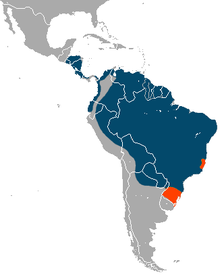大食蚁兽
大食蚁兽(学名:Myrmecophaga tridactyla)是异关节总目披毛目食蚁兽的一种,为一种大型的食虫动物,和树懒为近亲。分布在中美洲与南美洲部份地区,生活在草地、落叶林和雨林地区。主要以蚂蚁和白蚁为食,一天最多可食30,000只昆虫[3]。
| 大食蚁兽 化石时期:
| |
|---|---|

| |
| 科学分类 | |
| 界: | 动物界 Animalia |
| 门: | 脊索动物门 Chordata |
| 纲: | 哺乳纲 Mammalia |
| 目: | 披毛目 Pilosa |
| 科: | 食蚁兽科 Myrmecophagidae |
| 属: | 大食蚁兽属 Myrmecophaga Linnaeus, 1758 [2] |
| 种: | 大食蚁兽 M. tridactyla
|
| 二名法 | |
| Myrmecophaga tridactyla Linnaeus, 1758
| |

| |
| 蓝色:分布范围;橙色:可能已绝迹 | |
| 异名 | |
|
Myrmecophaga jubata Linnaeus, 1766 | |
大食蚁兽在现存四种食蚁兽中体型最大的成员,体长可达 182—217 cm(5.97—7.12英尺)。雄性体重通常为 33—41千克(73—90磅),雌性则为 27—39千克(60—86磅)[4]。体毛长而坚硬,可长40厘米,尾部密生长毛[5],头细长,眼耳极小并吻成管状,无齿,舌细长并能伸缩,借以舐食蚁类、白蚁及其他昆虫。前肢除第五指外,均具钩爪,后肢短,五爪大小相仿。体灰白色,背面两侧有宽阔的黑色纵纹,纹的边缘白色。大食蚁兽为独居动物,个体之间少有互动,少数例外为:雄性之间的示威、交配、以及养育后代。雌性大食蚁兽会将幼仔背在背上活动。
大食蚁兽被国际自然保护联盟列为易危物种,在许多地区面临局部地区灭绝。大食蚁兽所面临的威胁包括栖息地丧失以及盗猎取得其毛皮与肉。
包括两个亚种:
- Myrmecophaga tridactyla artata Osgood, 1912
- Myrmecophaga tridactyla centralis Lyon, 1906
描述
编辑大食蚁兽的头颅长达 30 cm(12英寸)[6],即使和食蚁兽比起来仍然特别细长[7],管状的吻突占了大部分。大食蚁兽的眼睛与耳朵很小[4],视力不好,但嗅觉的敏感度为人类的 40 倍[8]。在人工饲育的环境下,大食蚁兽的可活约 16 年[5]。
大食蚁兽的前后足均有五趾,其中前足有四趾带爪,第二与第三趾上的爪子长度最长[3]。大食蚁兽用指节著地的形式行走,类似于现今的大猩猩、黑猩猩,以及已灭绝的大地懒与爪兽,可以避免其长爪因接触到地面而磨损。主要承受重量的第三趾,具有延长的掌指关节,可弯曲于指骨间关节[9]。和前足不同,大食蚁兽的后足五趾上均具有短爪,为踯行动物[4]。大食蚁兽扩大的棘上窝给予大圆肌更多的附著点,强化前足回拉的力量。而三头肌则提供前足第三趾弯曲的力量[10],这些肌肉可以帮助大食蚁兽挖掘并破坏白蚁的蚁冢。
保育状况
编辑它们被列为《濒危野生动植物种国际贸易公约》附录二的物种,被限制出口及贸易。
参考文献
编辑- ^ Miranda, F.; Bertassoni, A. & Abba, A.M. Myrmecophaga tridactyla. The IUCN Red List of Threatened Species (IUCN). 2014, 2014: e.T14224A47441961 [3 January 2018]. doi:10.2305/IUCN.UK.2014-1.RLTS.T14224A47441961.en.[永久失效链接]
- ^ Linnæus, Carl. Systema naturæ per regna tria naturæ, secundum classes, ordines, genera, species, cum characteribus, differentiis, synonymis, locis. Tomus I 10th. Holmiæ: Laurentius Salvius. 1758: 35 [23 November 2012]. (原始内容存档于2012-11-08) (拉丁语).
- ^ 3.0 3.1 Naugher, K. B. Anteaters (Myrmecophagidae). Hutchins, M.; Kleiman, D. G.; Geist, V.; McDade, M. С. (编). Grzimek's Animal Life Encyclopedia 13 2nd. Gale. 2004: 171–79. ISBN 0-7876-7750-7.
- ^ 4.0 4.1 4.2 Smith, P. Giant Anteater Myrmecophaga tridactyla Linnaeus, 1758 (PDF). Fauna Paraguay.com. 2 November 2007 [13 June 2012]. (原始内容 (PDF)存档于2013-09-26).
- ^ 5.0 5.1 Eisenberg, J. F.; Redford, K. H. Mammals of the Neotropics: The Central Neotropics: Ecuador, Peru, Bolivia, Brazil. University of Chicago Press. 2000: 92–93 [2018-10-30]. ISBN 0-226-19542-2. OCLC 493329394. (原始内容存档于2019-06-11).
- ^ Naples, V. Anteaters. MacDonald, D (编). The Encyclopedia of Mammals 2nd. Oxford University Press. 2001: 788–91. ISBN 0-7607-1969-1.
- ^ Naples, V. L. Morphology, evolution and function of feeding in the giant anteater (Myrmecophaga tridactyla). Journal of Zoology. 1999, 249 (1): 19–41. doi:10.1111/j.1469-7998.1999.tb01057.x.
- ^ Rodrigues, F. H. G.; Medri, Í. M.; Miranda Mourão, G. de; Camilo-Alves, C. de S. e; Mourão, G. Anteater behavior and ecology. Vizcaíno, S. F.; Loughry, W. J. (编). The Biology of the Xenarthra. 2008: 257–68. ISBN 978-0-8130-3165-1. OCLC 741613153.
- ^ Orr C. M. Knuckle-walking anteater: a convergence test of adaptation for purported knuckle-walking features of African Hominidae. American Journal of Physical Anthropology. 2005, 128 (3): 639–58. PMID 15861420. doi:10.1002/ajpa.20192.
- ^ Hall, B. K. Fins Into Limbs: Evolution, Development, And Transformation. University of Chicago Press. 2007: 304. ISBN 0-226-31337-9.
